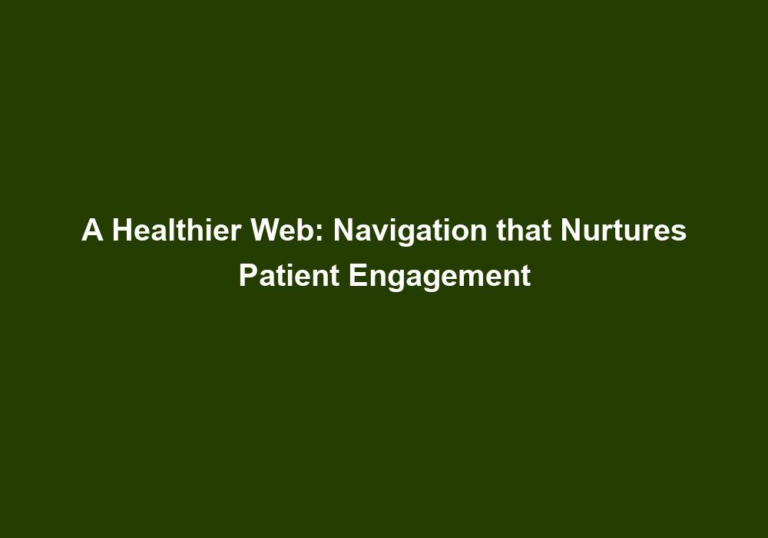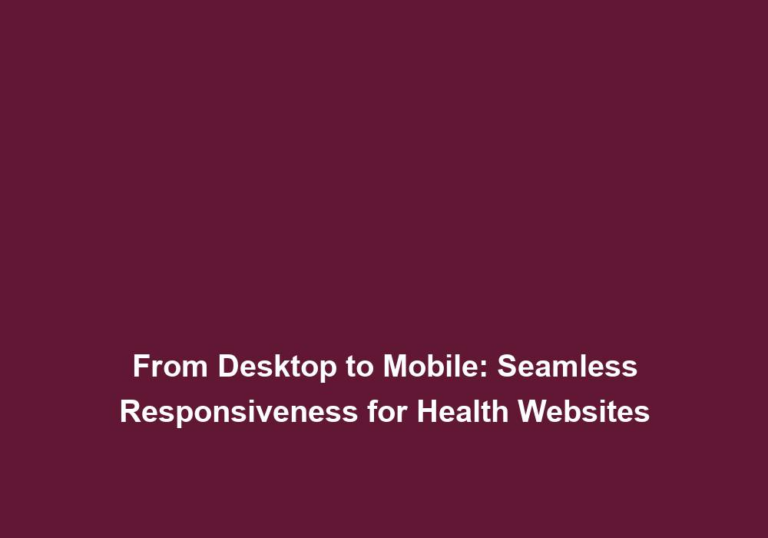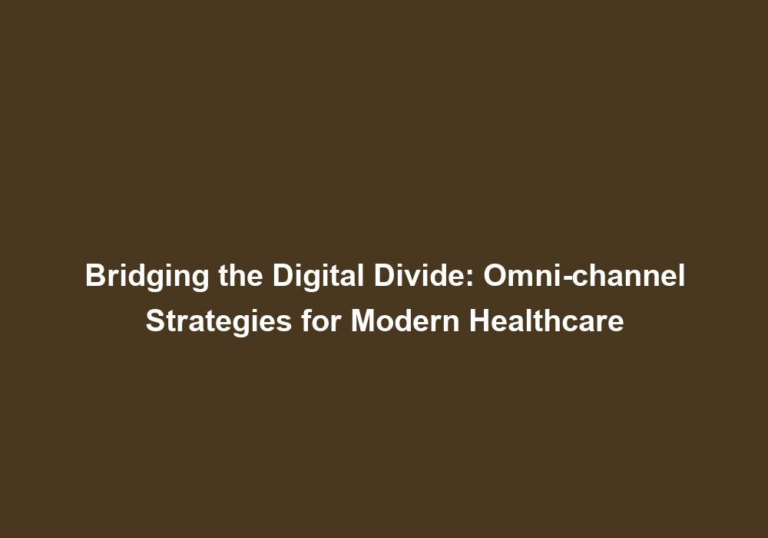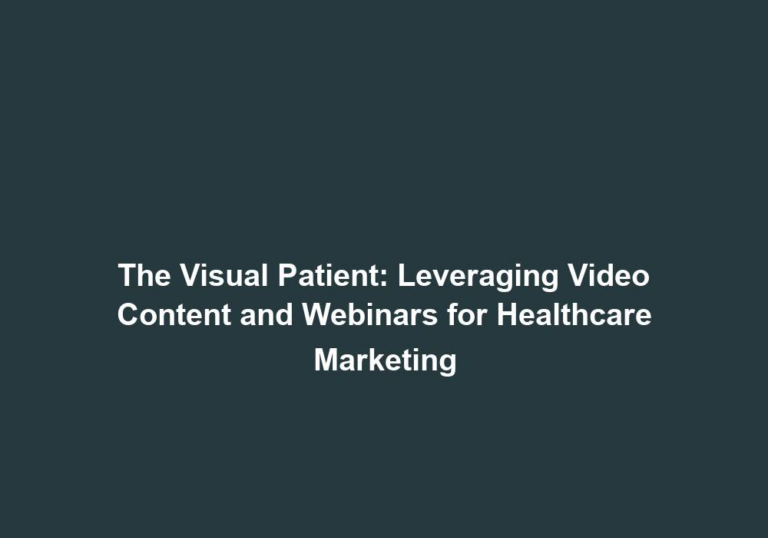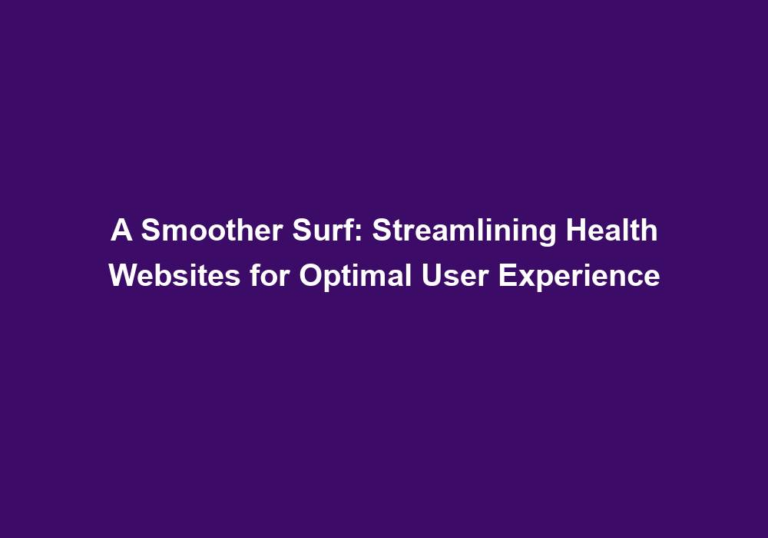Everywhere Care: Building a Consistent Omni-channel Healthcare Experience
In today’s fast-paced digital world, the healthcare industry is constantly evolving to meet the needs of patients who expect seamless, convenient, and personalized experiences. The concept of Everywhere Care has emerged as a solution to provide a consistent omni-channel healthcare experience. This article will delve into the importance of Everywhere Care and how it can be achieved to enhance patient satisfaction and improve healthcare outcomes.
The Rise of Everywhere Care
Everywhere Care is a term that encompasses the integration of various channels and touchpoints within the healthcare ecosystem to create a unified and consistent experience for patients. It recognizes the need to meet patients where they are, irrespective of their preferred channel of communication.
The growing influence of technology in healthcare has catalyzed the demand for Everywhere Care. Patients now expect to interact with healthcare providers through a multitude of channels such as websites, mobile apps, social media, telemedicine, and more. By embracing and implementing Everywhere Care, healthcare organizations can deliver personalized care across these channels, thereby enhancing patient engagement and satisfaction.
Benefits of Everywhere Care
Implementing Everywhere Care within a healthcare organization offers numerous benefits for both patients and providers. Some of the key advantages include:
- Enhanced Patient Experience
Everywhere Care facilitates a seamless patient experience by enabling access to healthcare services at any time and from anywhere. Patients can schedule appointments, view test results, communicate with providers, and access educational resources through a variety of channels. This convenience leads to increased patient satisfaction and loyalty.
- Improved Continuity of Care
By integrating multiple touchpoints, Everywhere Care ensures that patients’ interactions with healthcare providers are consistent across various channels. This enables a seamless flow of information, reducing the likelihood of miscommunication or gaps in care. Healthcare professionals can access patients’ medical history and treatment plans, irrespective of the channel used, resulting in improved continuity of care.
- Personalized Healthcare
Everywhere Care allows healthcare providers to offer personalized experiences by leveraging patient data collected from various channels. By analyzing patient behavior, preferences, and medical history, providers can tailor recommendations, treatment plans, and educational resources accordingly. This personalized approach enhances patient engagement and improves healthcare outcomes.
- Increased Access to Healthcare Services
In remote or underserved areas, Everywhere Care can play a pivotal role in improving access to healthcare services. Telemedicine and virtual consultations enable patients to receive expert medical advice without the need for physical travel, reducing barriers to care. Additionally, online appointment scheduling and virtual waiting rooms minimize wait times and optimize the utilization of healthcare resources.
Implementing Everywhere Care
To effectively implement Everywhere Care, healthcare organizations need to consider the following strategies:
1. Integrated Technology Infrastructure
A robust and integrated technology infrastructure is the foundation of a successful Everywhere Care implementation. It involves the integration of electronic health record (EHR) systems, patient portals, mobile apps, telemedicine platforms, and other relevant technologies. This integration enables seamless data exchange and access, ensuring a consistent patient experience across channels.
- Implement a secure and scalable electronic health record (EHR) system that allows for easy data sharing and collaboration among healthcare providers.
- Develop user-friendly patient portals and mobile apps that provide access to medical records, appointment scheduling, and communication with healthcare providers.
- Integrate telemedicine platforms to enable virtual consultations and remote monitoring, ensuring access to healthcare services irrespective of physical location.
2. User-centric Design
Designing user-centric interfaces for various channels is crucial for achieving Everywhere Care. Websites, mobile apps, and patient portals should be intuitive, easy to navigate, and visually appealing. User experience (UX) design principles should be implemented to ensure that patients can effortlessly access the information and services they need.
- Conduct user research to understand the needs and preferences of patients, and design interfaces that cater to their requirements.
- Implement responsive design techniques to ensure that the interfaces are accessible and user-friendly across different devices and screen sizes.
- Regularly gather feedback from patients and make iterative improvements to the user interface based on their input.
3. Data Analytics and Personalization
Leveraging data analytics is essential to provide personalized experiences through Everywhere Care. By analyzing patient data, such as demographics, medical history, and preferences, healthcare providers can tailor interventions, recommendations, and educational content. Advanced analytics tools can identify patterns and trends, enabling proactive healthcare delivery.
- Implement data analytics platforms that can process and analyze large volumes of patient data to derive insights and identify trends.
- Use predictive analytics to anticipate patient needs and provide personalized recommendations for treatment and preventive care.
- Leverage machine learning algorithms to automate the identification of high-risk patients and deliver targeted interventions.
4. Communication and Collaboration
Effective communication and collaboration among healthcare professionals are critical to Everywhere Care. Integrated messaging systems, secure email platforms, and video conferencing tools facilitate seamless information exchange and coordination between providers. This collaborative approach ensures that patients receive consistent and coordinated care across different channels.
- Implement secure messaging systems that allow healthcare providers to communicate securely and efficiently, ensuring the privacy and confidentiality of patient information.
- Utilize video conferencing tools to enable virtual meetings and consultations between healthcare providers, improving coordination and reducing the need for physical meetings.
- Foster a culture of collaboration and open communication among healthcare professionals, encouraging interdisciplinary teamwork and shared decision-making.
Challenges and Roadblocks
Although Everywhere Care offers numerous benefits, there are challenges that healthcare organizations may face during its implementation:
1. Data Security and Privacy Concerns
The integration of multiple channels and touchpoints requires robust security measures to protect patient data. Healthcare organizations must adhere to strict privacy regulations, such as the Health Insurance Portability and Accountability Act (HIPAA) in the United States, to ensure the confidentiality and integrity of patient information.
- Implement encryption and access controls to secure patient data across all channels and touchpoints.
- Regularly conduct security audits and penetration testing to identify vulnerabilities and address them promptly.
- Provide staff training on data security best practices and develop policies and procedures to ensure compliance with privacy regulations.
2. Infrastructure and Resource Constraints
Implementing Everywhere Care necessitates the availability of adequate technological infrastructure and resources. Healthcare organizations need to invest in robust IT systems, staff training, and ongoing maintenance. Limited financial resources and technical expertise may pose challenges for smaller healthcare providers.
- Conduct a comprehensive assessment of the existing IT infrastructure to identify gaps and prioritize investments accordingly.
- Explore partnerships and collaborations with technology vendors or other healthcare organizations to share resources and reduce costs.
- Provide training and support to healthcare staff to ensure they have the necessary skills and knowledge to effectively utilize the technology infrastructure.
3. Resistance to Change
Resistance to change can hinder the successful implementation of Everywhere Care. Healthcare professionals and staff may be reluctant to adopt new technologies or workflows, fearing job displacement or increased workload. Effective change management strategies and training programs are essential to overcome this resistance and ensure smooth integration.
- Clearly communicate the rationale behind implementing Everywhere Care and the benefits it will bring to both patients and healthcare professionals.
- Involve key stakeholders in the planning and decision-making process to foster ownership and engagement.
- Provide comprehensive training programs and ongoing support to healthcare staff to help them adapt to the new technologies and workflows.
Conclusion
Everywhere Care has become imperative in the healthcare industry to meet the evolving demands and expectations of patients. By providing a consistent omni-channel experience, healthcare organizations can enhance patient satisfaction, improve healthcare outcomes, and increase access to care. However, successful implementation requires a comprehensive strategy that encompasses integrated technology infrastructure, user-centric design, data analytics, and effective communication. Overcoming challenges such as data security concerns, resource constraints, and resistance to change is crucial for unlocking the full potential of Everywhere Care. Embracing this approach can pave the way for a future where healthcare is accessible, convenient, and patient-centric.
Note: The above article is provided in markdown format for the given title.


